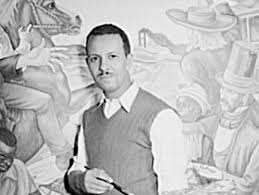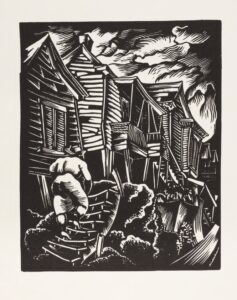Hale Aspacio Woodruff was born in Cairo, Illinois and grew up in Nashville, Tennessee. At age 19, he moved to Indianapolis to attend Herron Art School. He supported himself as a cartoonist and with odd jobs. After Herron, he continued painting and succeeding in local art competitions. In the coming years he studied art at the Harvard Fogg Art Museum and The Art Institute of Chicago. At age 28, he won the Harmon Foundation’s Bronze award, and with the modest prize money, he purchased a one-way ticket to Europe.

While in Paris, Woodruff studied Old Masters and attended art schools. He, also, fulfilled his dream of meeting Henry Ossawa Tanner (Tanner was 71). Upon his reluctant return to the states, Tanner accepted a teaching position at Atlanta University and created the country’s first fine art department for Southern black students. Still the student himself, he studied in 1938 in Mexico with the famous muralist Diego Rivera. Rivera’s influence can easily be seen in Tanner’s most widely acclaimed work The Amistad Murals (1938). The group of six murals was commissioned by Talladega College, Alabama. Three of the murals depict the 1838 slave uprising on the Spanish ship La Amistad. One panel depicts The Underground Railroad and the remaining two reflect the building of the college. A 2015 PBS video discussing a tour of the restored murals can be viewed here.
In 1966, he showed slides of his Amistad murals in Sierra Leone to descendants of the mutineers who made African and American history.

Coming Home by Hale A. Woodruff (held by Princeton University Art)
In the 1930s, Woodruff created a series of dramatic block prints which depicted Southern poverty and racial violence. Later, he lent his talents to abstract impressionism. In 1946, he joined the faculty of New York University in Manhattan where he taught for 20 years until his retirement.
Submitted by Carol Hobbs.
Sources: Wikipedia, Smithsonian American Art Museum, Talladega College, AAREG
